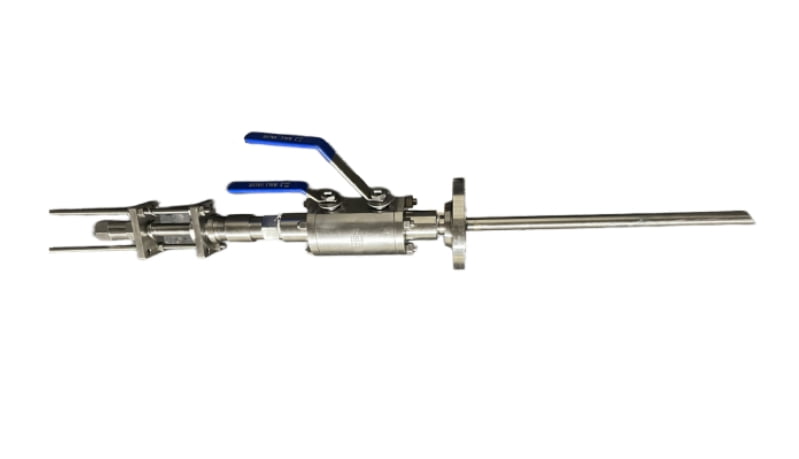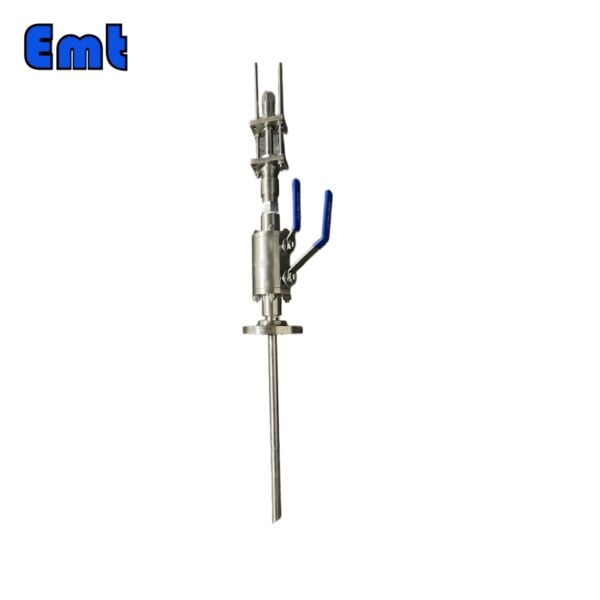Beschreibung
Einleitung
Chemikalien-Injektionspinolen sind wesentliche Komponenten in verschiedenen Branchen, darunter Öl und Gas, Wasseraufbereitung und kommunale Anwendungen, und werden zum präzisen Einbringen von Chemikalien in Rohrleitungen oder Systeme verwendet.
Wie chemische Injektionsnadeln funktionieren
Platzierung des Injektionspunkts: Chemikalien-Einspritznadeln werden strategisch an bestimmten Stellen innerhalb einer Rohrleitung oder eines Systems platziert, an denen eine Chemikaliendosierung erforderlich ist. Die Platzierung ist entscheidend, um eine effektive Vermischung und Verteilung der eingespritzten Chemikalie sicherzustellen.
Verbindung: Injektionspinolen werden typischerweise über Schläuche oder Rohrleitungen mit chemischen Injektionspumpen oder -systemen verbunden. Über diese Anschlüsse wird die zu injizierende Chemikalie aus einem Vorratsbehälter der Injektionspinole zugeführt.
Diffusion und Mischung: Die Injektionspinole ist mit einem Diffusor oder Mischelement ausgestattet. Wenn die Chemikalie durch die Pinole fließt, trifft sie auf dieses Element, das eine gründliche Vermischung mit der Primärflüssigkeit in der Rohrleitung fördert.
Druckregelung: Der Druck ist ein entscheidender Faktor bei der chemischen Injektion. Injektionspinolen dienen dazu, den Druck der eingespritzten Chemikalie so zu steuern, dass er den Anforderungen des Systems entspricht. Dies verhindert Probleme wie Rückfluss oder übermäßigen Druck, die zu Schäden an der Ausrüstung führen können.
Chemikaliendosierung: Die Chemikalie wird mit kontrollierter Geschwindigkeit in die Rohrleitung oder das System eingespritzt. Die Injektionsrate kann häufig an die spezifischen Behandlungsbedürfnisse angepasst werden.
Überwachung und Sicherheit: Einige Injektionsnadeln sind mit Überwachungsfunktionen ausgestattet, um sicherzustellen, dass die richtige Menge an Chemikalien injiziert wird. Sicherheitsmaßnahmen wie Leckerkennung und -eindämmung sind ebenfalls unerlässlich, um Umweltgefahren vorzubeugen.
Was ist ein Rückschlagventil?
Definition und Funktion von Rückschlagventilen
Rückschlagventile werden typischerweise in Rohren angebracht, um eine Strömungsumkehr zu verhindern. Im Wesentlichen funktionieren sie wie eine Tür, die nur in eine Richtung schwingt: Der Fluss kann sich frei in eine Richtung bewegen, aber wenn er versucht, sich umzukehren, schließt sich das Ventil. Diese Maßnahme schützt die Rohre, andere Ventile und Pumpen vor möglichen Schäden.
- Die in den Prozessstrom einzuspritzende Chemikalie fließt durch die chemische Einspritzpinole nach unten.
- Am Ende der Pinole wird die Chemikalie in die Mitte des Prozessstroms abgegeben und sorgt so für eine gleichmäßige Verteilung.
Wenn der Prozessstrom versucht, die Pinole hinaufzufließen, schließt das Rückschlagventil, verhindert einen Rückfluss und schützt die Chemikalienquelle und das Einspritzsystem vor möglichen Schäden.
Wie sie zusammenarbeiten
Eine chemische Injektionsnadel und ein Rückschlagventil arbeiten in einem System zusammen, um Chemikalien präzise zu dosieren und das System vor Rückfluss zu schützen. Eine chemische Injektionsnadel ist ein Gerät, das sicherstellt, dass die Chemikalien gleichmäßig in der Mitte des Strahls verteilt werden, wodurch die Misch- und Reaktionseffizienz verbessert wird. Typischerweise handelt es sich um eine rohrartige Struktur, die in das Rohr eindringt, in dem sich die Prozessflüssigkeit befindet. Ein Rückschlagventil hingegen ist ein Einwegventil, das den Durchfluss nur in eine Richtung zulässt. In Verbindung mit einer chemischen Injektionspinole verhindert es, dass die Prozessflüssigkeit nach dem Einspritzen der Chemikalie an der Pinole zurückfließt.
Hier ist die Reihenfolge, in der sie zusammenarbeiten:
- Die in den Prozessstrom einzuspritzende Chemikalie fließt durch die chemische Einspritzpinole nach unten.
- Am Ende der Pinole wird die Chemikalie in die Mitte des Prozessstroms abgegeben und sorgt so für eine gleichmäßige Verteilung.
- Wenn der Prozessstrom versucht, die Pinole hinaufzufließen, schließt das Rückschlagventil, verhindert einen Rückfluss und schützt die Chemikalienquelle und das Einspritzsystem vor möglichen Schäden.
Somit gewährleistet die Kombination aus einer Chemikalien-Einspritznadel und einem Rückschlagventil eine präzise Chemikalienabgabe bei gleichzeitiger Wahrung der Integrität des Systems.
Bedeutung von Chemikalien-Einspritzpinolen mit Rückschlagventilen
Rückschlagventile spielen eine entscheidende Rolle beim Schutz von Systemen vor Rückfluss, einem Problem, das durch plötzliche Druckabfälle, Temperaturänderungen oder fehlerhafte Pumpen entstehen kann. Rückfluss kann die Fließrichtung einer Flüssigkeit umkehren, was zu möglichen Verunreinigungen und Geräteschäden führen kann.
Rückschlagventile werden oft als Einweg- oder Rückschlagventile bezeichnet und sind so konzipiert, dass sie den Flüssigkeitsfluss nur in eine Richtung zulassen. Sie schließen automatisch, wenn Flüssigkeit versucht, in die entgegengesetzte Richtung zu fließen, und dienen so als Schutzbarriere für das System. Das Schöne an Rückschlagventilen liegt in ihrem passiven Betrieb – sie erfordern keinen manuellen Eingriff oder externe Stromversorgung, was sie zu einer zuverlässigen Lösung zur Verhinderung von Rückfluss macht, selbst in unvorhergesehenen oder Notfallsituationen.
In einem System, das mit einer chemischen Injektionsnadel ausgestattet ist, ist die Rolle eines Rückschlagventils noch wichtiger. Das Fehlen eines Rückschlagventils könnte einen Rückfluss ermöglichen, der die eingespritzte Chemikalie zurück in das Einspritzsystem drückt. Dies kann je nach den beteiligten Substanzen zu einer Systemverunreinigung, einer Verschwendung von Chemikalien oder sogar zu gefährlichen Zuständen führen. Durch die Verhinderung eines Rückflusses schützt das Rückschlagventil somit das Injektionssystem und die Chemikalienquelle und gewährleistet gleichzeitig die Sicherheit und Effizienz des Chemikalieninjektionsprozesses.
Sicherheitsaspekte von Chemikalien-Injektionspinolen mit Rückschlagventilen
Wie Rückschlagventile dazu beitragen, dass Systeme ordnungsgemäß funktionieren
Rückschlagventile spielen eine Schlüsselrolle dabei, sicherzustellen, dass Systeme mit chemischen Injektionspinolen ordnungsgemäß funktionieren. Diese Ventile sind so konzipiert, dass Flüssigkeit nur in eine Richtung fließen kann, und sie schließen automatisch, wenn die Flüssigkeit versucht, rückwärts zu fließen.
In einem System, das eine chemische Injektionsnadel verwendet, verhindert das Rückschlagventil, dass die Chemikalien oder Prozessflüssigkeit zurück in das Injektionssystem gelangen. Dies ist sehr wichtig, da ein Rückfluss der Flüssigkeit oder Chemikalien zu Verunreinigungen, Chemikalienverschwendung oder sogar zu Schäden an der Ausrüstung führen könnte. Indem es diesen Rückfluss stoppt, trägt das Rückschlagventil dazu bei, dass das System ordnungsgemäß und reibungslos funktioniert.
Die Rolle von Rückschlagventilen für die Sicherheit von Arbeitnehmern und Umwelt
Rückschlagventile sorgen nicht nur dafür, dass Systeme ordnungsgemäß funktionieren, sondern tragen auch zur Sicherheit von Mensch und Umwelt bei. Bei vielen chemischen Prozessen werden Materialien verwendet, die gefährlich sein können, wenn sie nicht unter Kontrolle gehalten werden. Wenn beispielsweise ein chemisches Einspritzsystem einen Rückfluss ermöglicht, könnten die Chemikalien an Stellen gelangen, an denen sie nicht hingehören, und möglicherweise den Arbeitern schaden.
Ein Rückschlagventil verhindert dies, indem es einen Rückfluss verhindert, das Risiko einer versehentlichen Chemikalienexposition verringert und zur Sicherheit der Arbeiter beiträgt. Darüber hinaus tragen Rückschlagventile dazu bei, mögliche Umweltschäden durch Lecks oder Verschüttungen zu verhindern, indem sie die Chemikalien im System zurückhalten.
Auch wenn im System etwas schief geht oder sich die Bedingungen plötzlich ändern, bietet die automatische Schließfunktion des Rückschlagventils zusätzliche Sicherheit. Es kann einen plötzlichen Anstieg oder eine Umkehr des Durchflusses stoppen, was andernfalls zum Ausfall von Geräten oder sogar zu einem gefährlichen Systemausfall führen könnte.









Rezensionen
Es gibt noch keine Bewertungen.